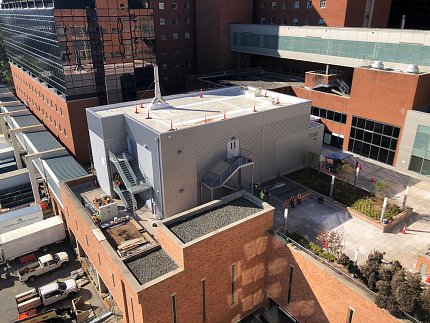CC’s Center for Cellular Engineering Unveils New Manufacturing Facility

The Clinical Center’s (CC) Center for Cellular Engineering (CCE) recently unveiled its new Modular Terrace Facility.
First conceived in 2017, the custom-designed, 8,000-square-foot structure features four manufacturing clean rooms spanning 3,000 square feet and another 1,000 square feet of support space.
“There’s no research space in this building,” said CCE Deputy Director Dr. Rob Somerville. “It’s all dedicated to manufacturing.” Unlike most commercial facilities, which focus production on one or two cell- or gene-therapy products, CCE oversees a broad portfolio.
Somerville said the new Modular Terrace Facility will directly support CCE’s mission to produce therapies for patients enrolled in trials.
These range from stem cells for bone marrow transplants and CAR T-cell immunotherapies for cancer patients to CCE’s most advanced product, a graft of retinal pigment epithelial cells for patients with macular degeneration.
To produce epithelial cells, CCE staff reprogram blood cells drawn from a patient sample to create induced pluripotent stem cells (iPSCs), a form of lab-generated embryonic stem cell.
“We then select basic cultures of these cells, pick the best one, and then…go through a differentiation process to turn them into retinal pigment epithelial cells,” Somerville said.
The cells are later transferred to a scaffold used by an ocular surgeon to implant into a patient who has suffered vision loss caused by macular degeneration.
“This is first in human,” Somerville explained, noting that the manufacturing process is protracted. “So far only a single patient has been treated with this therapy. It takes multiple months, and we’re still just a proof-of-concept stage.”
Noting that requested cell and gene therapies for CC patients are constantly in flux, the scientist said CCE’s new terrace facility will increase production capacity.
“We can manufacture different products in different rooms, and they won’t impinge on whatever is going on in adjacent rooms, which gives us a lot of flexibility,” he said.
A key feature of the state-of-the-art facility is that it can be easily cleaned—a crucial requirement to ensure a sterile manufacturing environment to produce patient products free of hospital-acquired infections.
“This facility is a new tool that NIH can use for [many] years looking forward,” Somerville concluded. “Rather than designing a facility for where we are now, we’ve created flexibility…It is forward thinking.”
